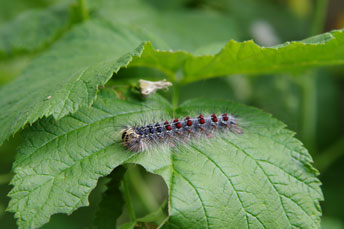
Gypsy moths need to be of concern to any property owner. This little insect is capable of decimating a forest in a short period of time, thanks to his or her ferocious appetite. When outbreaks occur these insects feast on most types of trees for a period of two to three months. In 2016, Massachusetts saw Gypsy Moths responsible for 350,000 acres being defoliated; areas of Rhode Island were hit even harder. This caused severe stress on trees that then went through a brutal summer drought. Many trees did not recover from this damage and this led to very costly tree removals for many residents. With 2017 repeating as another bad year for caterpillar damage we fear hundreds of thousands of trees could be at risk of being killed this summer. The large numbers of caterpillars also cause other property concerns; houses, cars, fences, patios, and pools get covered by the hairy insects and their greasy poop which causes stains and for many people an itchy painful rash called contact dermatitis. Gypsy Moth Control needs to be a priority due to the damage they cause, but property owners often wonder what steps they should take to keep these pests at bay.
Some homeowners attempt to wrap their trees with Tanglefoot and duct tape to control Gypsy Moths. Wrapping duct tape around the trunk of a tree about chest height and smearing Tanglefoot on the center of this tape. Be aware that this substance is extremely sticky and will not come off of clothes, thus individuals have to be very careful to not allow it to touch their skin or what they are wearing. As the moth attempts to climb the tree, it becomes stuck to the Tanglefoot, it can then be scraped off and put into a jar with dish detergent and water in it. If you do not regularly remove the stuck caterpillars their bodies will form a bridge and the continuing masses will crawl over them. This is a very messy and time consuming process. We also do not recommend this as it damages the bark if it drips off of the tape and leaves permanent stains on the bark. It also is very unattractive to see large taped bands encircling your trees. While it will stop many caterpillars, in our eyes this defeats the purpose of trying to keep your landscape healthy and looking its best.
Insecticidal sprays are the most effective way to control gypsy moths. Many individuals choose to turn this task over to the professionals like Simply Safer Premium Lawn Care. We make use of a mild insecticide to treat your property and results are seen in a short period of time. In fact, a property owner may find the problem has been eliminated the same day the treatment was carried out. There are two options that we offer:
The option that we recommend most is a blanket application of a mild insecticide Bifenthrin to treat the property for caterpillars and ticks at the same time! Bifenthrin is a pyrethroid, a manmade version of a pyrethrin, which come from chrysanthemum flowers. This thorough application is applied to the woodline, mulchbeds, around the house and patios, on the base of all trees and shrubs, up 15 to 20 feet into your trees, and across border areas of the lawn. Some tree companies spray way to the top of even the tallest trees. We do not, as we find this to be a very irresponsible practice where the drift cannot be controlled. Even most the caterpillars at the tops of tall trees drop down, accidentally or by ballooning, while still small and then crawl across the treated areas at the base and die before they can climb up your trees and cause substantial damage. In almost all cases one application is sufficient to control the caterpillars. If your neighborhood is decimated a follow up spray may be called for to make sure the barrier is intact. As noted above this application also kills the ticks that are active on your property and so other areas of tick habitat are focused on to help keep your family safe. May and June is the most important time of year to have your property sprayed for ticks to prevent Lyme Disease and other tick born illnesses.
The second option we employ is somewhat less effective but is the safest product and what we recommend for those who raise bees or eat the fruit from their trees, it is a bacterial spray of Btk (Bacillus Thuringiensis Kurstaki) it can be effective for gypsy moth control if sprayed on foliage that is being eaten by small caterpillars, be sure that the newly hatched caterpillars have settled to feed on fully expanded foliage and are roughly between ¼ – ¾ inch in length. It’s best done in May and early June as it is not fully effective on caterpillars larger than 3/4” however. This spray also typically requires multiple sprays reapplied 10 to 14 days apart.
Furthermore, if you suffer damage, we also schedule to come again the following spring and time the application to be made as UMass reports to us that the caterpillars are beginning to emerge in your area. This ensures that your trees aren’t harmed again and are given a chance to fully recover. Consider going this route if gypsy moths have been a problem in the past. We also offer many more tree and shrub services and highly recommend our Tree and Shrub Program which feeds and protects your ornamental trees and shrubs against most insects and fungal diseases. This ensures the landscape remains beautiful year round.
For more information on Gypsy Moth’s, read this article on the Mass Audubon website.
